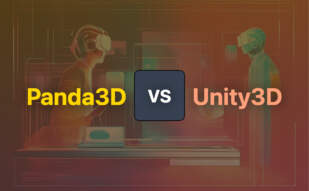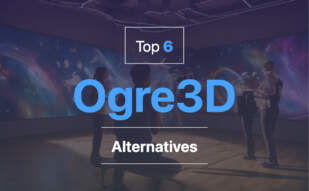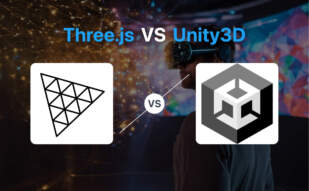
Unity3D
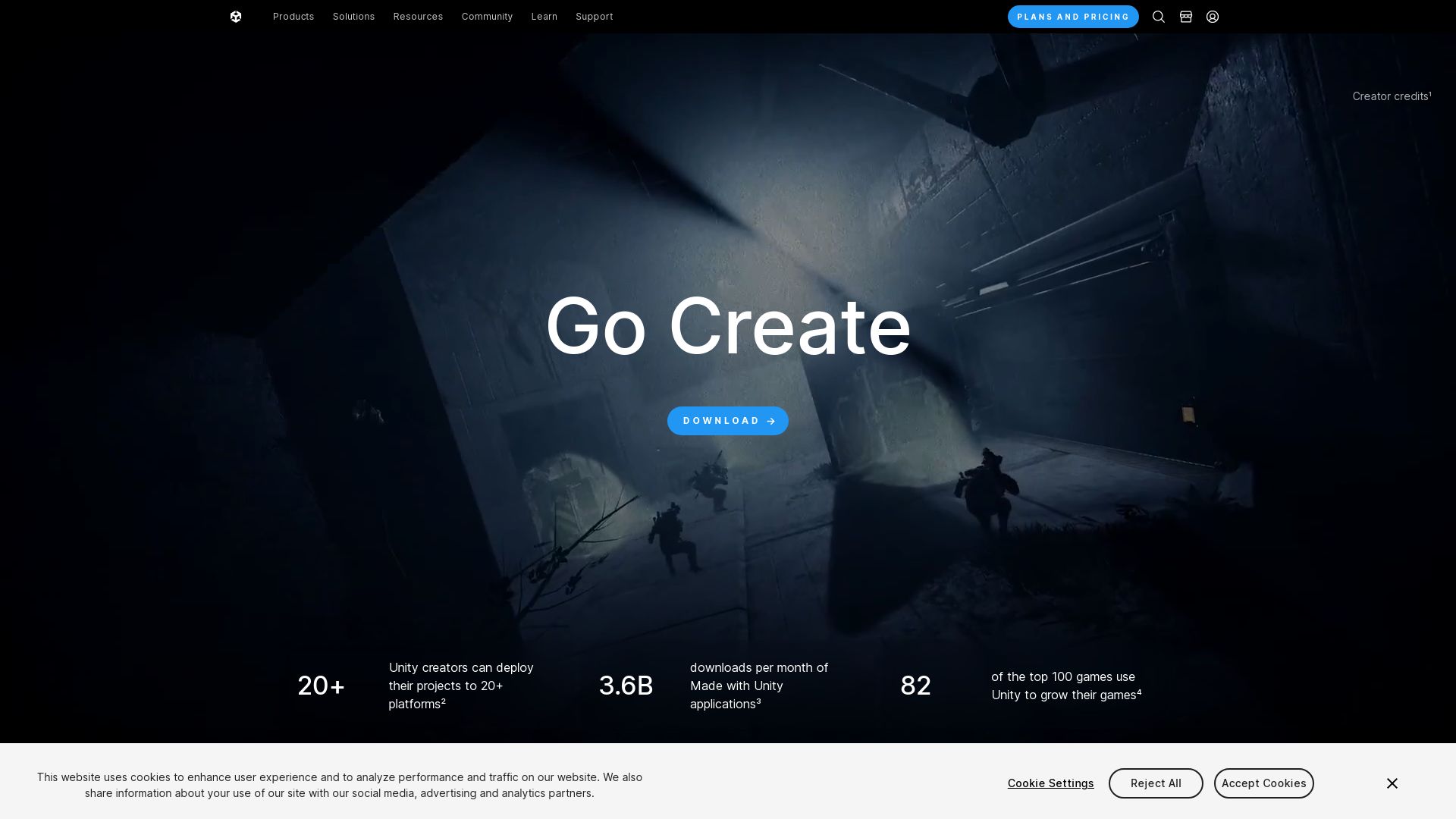
Cross-platform, beginner-friendly and backed by a strong user community, Unity3D is a powerful game engine released by Unity Technologies in 2005. Known for its potency in iOS and Android mobile game development, it has made headways into industries beyond just gaming, such as film, architecture, the U.S. Armed Forces and more.
Unity3D Top Features
- Cross-platform game engine with support for various desktop, mobile, console, and virtual reality platforms.
- Offers ease of use, thereby making it ideal for novice developers and also for indie game development.
- Integration with Visual Studio, C# scripting API, JavaScript scripting language and Mono Develop IDE.
- Employs 2D and 3D creation, with the Box2D engine used for 2D physics.
- Large collection of scripts, models, scenery, materials, and other items available on Unity marketplace.
| Developed In | C++ |
| Optimization | Fine-tuned for performance |
| Custom Scripting Tools | A rich API to build tailored scripting tools |
Unity3D Disadvantages
- Eligibility for use is based on financial parameters like revenue thresholds.
- ‘Per Install’ fee to kick start from January 1, 2024, based on game installs.
Unity3D Pricing
Unity3D offers flexible pricing for students, personal use and enterprises. It’s commercial terms are most affordable for game development up to a revenue threshold of $200,000. Prices for various plans and licenses vary, featuring extras, and could go up to $1500.
Unity3D Use Cases
Use Case 1 – Mobile Game Development
Because of its adaptability and integration abilities, Unity3D is extensively used for iOS and Android mobile game development.
Use Case 2 – Indie Game Development
Unity3D is highly popular within indie game development due to its simplicity and the vast array of tools made available at affordable rates.
Use Case 3 – Non-gaming Industries
Beyond just games, Unity3D is adopted by industries such as film, automotive, construction among others due to its advanced features enabling 3D visualization.
Godot
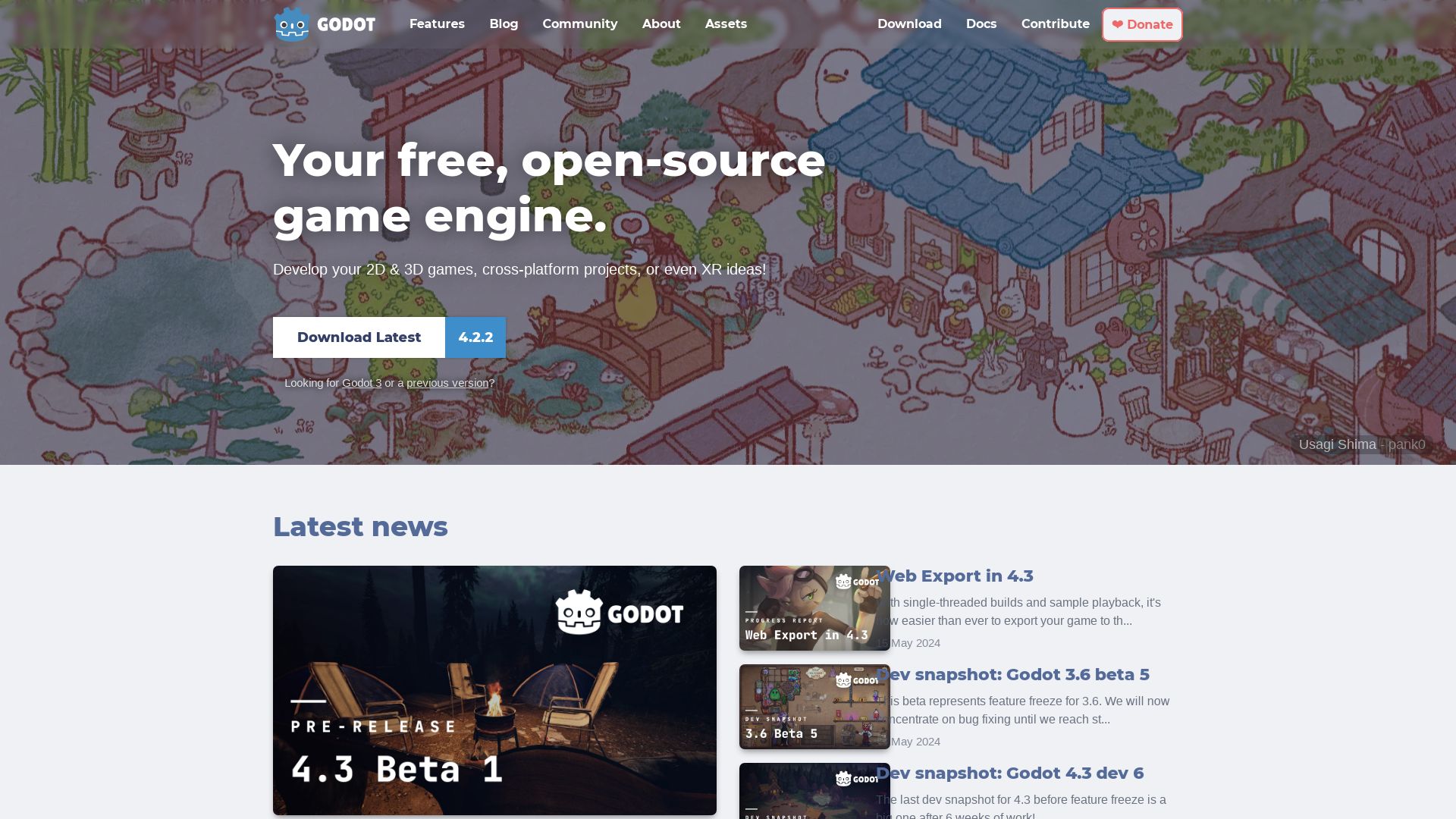
Making its grand entrance onto the stage of game development engines is none other than Godot. This unique player, hailing from the theatrical scene of 1953 Paris, represents a conundrum of delivery wrapped in open-source freedom.
Godot Top|Best Features
- Intuitive scene-driven design allowing for complex, reusable game creation from base building blocks.
- Built-in scripting language, GDScript, complemented by static typing support and tight engine integration for streamlined game logic application.
- .NET support for desktop platforms in Godot 4, with down-the-line language bindings like Rust, Nim, Python made available through the modifiable open-source codebase.
- Provision of high and low-end device support with a 3D engine that directly imports files from Blender.
- Specialized 2D workflow included in a package free of licensing fees, contracts or hidden costs.
| Supported Languages | Platforms |
|---|---|
| Official: GDScript, C++, C# Community Support: Rust, Nim, Haskell, Clojure, Swift & D |
Windows, macOS, Linux |
| Android phones & tablets (Godot 3.5), Various Mobile & Web platforms |
Godot Limitations
- Not suitable for complex 3D game development requirements.
Godot Pricing
This development engine comes completely free, under an MIT license. Freed from contracts, licensing fees, or hidden costs, every gamer remains in full ownership of their games.
Godot Use Cases
Use case 1
For developers seeking unrestricted customization, Godot’s open-source codebase and diverse language support make it an ideal choice.
Use case 2
Those with an idea for a 2D game/app will find Godot’s specialized 2D workflow a winning vector for their project.
Use case 3
Teams requiring a collaborative storage solution will appreciate Godot’s facilitation of team collaboration.
jMonkeyEngine
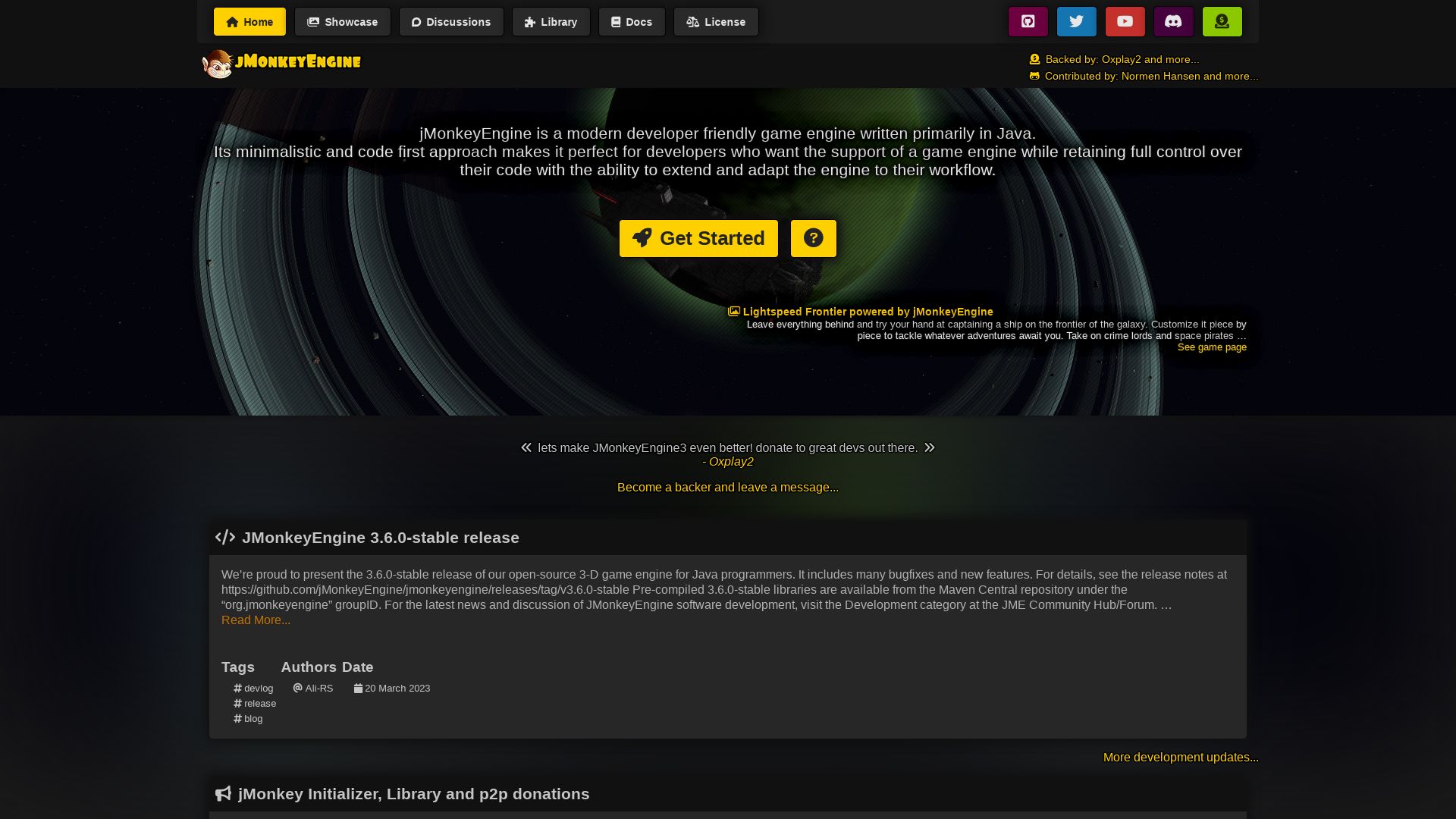
Let’s monkey around a bit with jMonkeyEngine! This Java-based, open-source 3D game engine, sits on a tree branch of its own. Notoriously minimalistic with its code-first approach, it swings on the vines of Android capability and is a darling for developer types. It powers Mythruna, an RPG game currently under development, with its bananas.
jMonkeyEngine Top Features
- Monkey around in 3D with its open-source 3D game engine for Java programmers.
- Build interfaces with a variety of GUI options including Lemur, Nifty GUI, and IGUI.
- Immerse yourself in the jungle sounds with its 3D audio support backed by OpenAL.
- Easily adapt to different paradigms including the Spatial-Control model and Zay-ES.
| Advanced particle capabilities | This engine doesn’t monkey around when it comes to particle proficiency! |
| Bullet Physics Support | Ensures that your game dynamics don’t go bananas. |
| Post-processing features | Get shiny visuals out of the box with filters like Bloom FXAA, Light Scattering, and more! |
jMonkeyEngine Downsides
- Not for the tech-challenged. This one screams code-first and minimalistic.
- Despite having a good online presence, it does have limitations compared to industry behemoths like Unity.
jMonkeyEngine Pricing
Wait for it… it’s for FREE! Yes, you read that right; jMonkeyEngine swoops in with an open-source BSD 3-Clause license.
jMonkeyEngine Use Cases
Use case 1
Are you a developer interested in monkeying around with 3D game creation? Then jMonkeyEngine is your favorable branch.
Use case 2
For hobbyists and tech-savvy students, jMonkeyEngine’s free-license makes it a great base for game-education programs.
Use case 3
Game developers preferring flexibility over Unity’s limitations relish jMonkeyEngine’s open source and freeing developing landscape.
O3DE
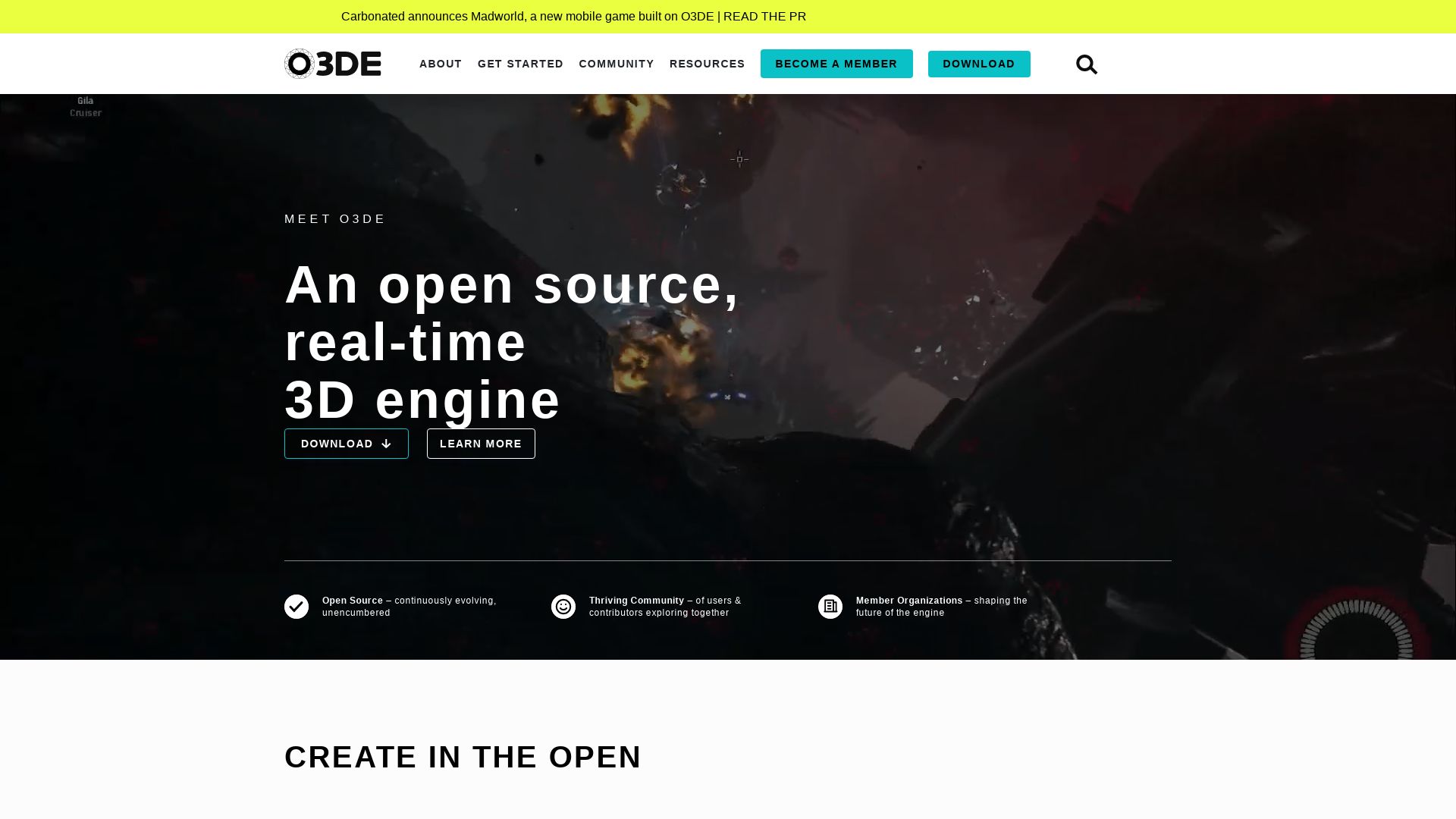
The O3DE, an open-source, real-time 3D engine developed by the Open 3D Foundation, excels in crafting interactive, high performance experiences. Incepted in July 2021, it’s nurtured by a consortium of tech leaders including Adobe, AWS, Epic Games, Huawei, Intel, Microsoft, and Niantic among others.
O3DE Top Features
- Modular Architecture: Engine and components are organized as Gems – libraries with standard interfaces. Precompiled gems can be added or removed without recompiling O3DE.
- Multiple Language Support: O3DE is written in C++, Lua, and Python, widening compatibility.
- In-depth Runtime Logic: Script Canvas or Lua can be employed for runtime logic, enhancing interactivity.
- Diverse Networking Capabilities: Enables creation of immersive, multi-player environments.
- Efficient Asset Workflows: Employs data-driven strategies for quicker asset deployment.
| Extended Features | Suitability |
|---|---|
| Python Scripting Support | Offers greater automation and interactivity. |
| High-Performance Math Libraries | Boosts computational efficiency. |
| Physically Based Renderer | Offers a more life-like gaming experience. |
O3DE Disadvantages
- The Lumberyard-based New World game garnering middling reviews points towards the need for further enhancements and refinements.
- Despite strong industry support, it still faces heated competition in the form of Unreal Engine, Godot, Unity.
- It has certain system requirements such as Windows 10 1809 or higher, or Ubuntu 20.04 or higher, limiting its applicability.
O3DE Pricing
Leveraging the advantage of open source, O3DE can be utilized for free, subject to the licenses granted – Apache License, Version 2.0, MIT license.
O3DE Use Cases
Use case 1
Game/Simulation Development: Assets can be effortlessly constructed, and complex games/simulations created with O3DE.
Use case 2
Physics Simulations: O3DE can simulate real-world physics, making it a potent tool for educators and researchers.
Use case 3
Cinematics Creation: With its advanced rendering capabilities, O3DE is ideal for creating cinematic experiences for games or films.
LibGDX
LibGDX is a Java game development framework providing a unified API for cross-platform targeting, including Windows, Linux, macOS, Android, iOS, and Web. Established over 10 years ago, it is known for its solid foundation, reliability, and comprehensive documentation.
LibGDX Top Features
- Extensive third-party ecosystem: Opens up varieties of customization and functionality.
- Code-centric, fine-grained control: Offers developers an intricate control over their project.
- Audio Streaming & Input Handling: Supports playback and recording with gesture detection for diverse input types.
- Robust 3D & 2D physics: Facilitates creation of immersive gaming experiences.
- Google Play Games, Apple Game Center integration: Simplifies incorporation of game services.
| Networking | Graphics |
|---|---|
| Equipped with TCP sockets, HTTP Request and WebSocket support. | Includes vertex arrays, vertex buffer objects, meshes, textures, framebuffer objects, shaders, and simple shape rendering. |
| Firebase, AdMob integrations and more | High-level APIs such as Orthographic camera, sprite batching and caching, |
LibGDX Limitations
- Despite being feature-rich, its code-centric approach could be intimidating for beginners.
- Relies on the JVM, so it lacks the performance benefits of native programs.
- Being open-source, its support system relies on community responsiveness, potentially leading to delayed issue resolution.
LibGDX Pricing
Great news, LibGDX is free to use and fully open-source under the Apache 2.0 license.
LibGDX Use Cases
Use Case 1: Indie Game Developers
With its extensive features and cross-platform project support, LibGDX becomes a viable alternative for indie game developers offering quick prototyping and asset importing through fbx-conv.
Use Case 2: Educational Institutions
With its well-documented and in-depth tutorials, LibGDX can be beneficial in academic settings for computer science and game development courses.
Use Case 3: Professional Game Development Studios
LibGDX’s comprehensive feature set, OpenGL rendering, scalable approach to game development, and extensive 3rd party ecosystem make it suitable for professional game development studios willing to leverage the power of an established Java ecosystem.
Unity

Welcome to the maverick realm of Unity, a formidable game development engine that waved its flag in 2005. Unity didn’t confine itself to 3D games. It decided to create magic in the 2D space too, scoffing at day-to-day norms. Its trump card? An engine versatile enough to allow seamless launches of cross-platform games on Android and iOS.
Unity Top Features
- One-stop destination for top-notch rendering tech and a plethora of tools and features for high-quality game creation.
- Isn’t pigeonholed in one OS. Rather, it adapts like a chameleon to several OS – fostering creation of applications from Augmented Reality to 3D simulations.
- Boosts minds with the Unity Asset store ingrained with diverse textures and features for brainstorming game designs.
- Offers dashboard of coding languages – Boo script, JavaScript, and C#.
- Houses a thriving developer community lending helping hands in problem-solving and feedback.
- Works tirelessly on tech evolution to enhance user-friendliness, compatibility, and immersive visual experiences. Because who likes monotonous?
| Feature | Description |
| Adaptive | When the worlds of AR and VR unfurl, Unity stays a step ahead, fostering creation of mobile games enriched with AR/VR features. |
| Learning & Communication | Keeps its users engaged in fresh learnings about industry solutions and encourages open communication threads for robust problem-solving. |
| Collaboration | Committed to fuel cooperation among members, thus amplifying the entire game development ecosystem. |
Unity Limitations
- Puts indie, mobile developers in the trenches with the pricing redesign into per-install fees, potentially ramping up costs with repeated downloads by a single user.
- Bygone trust due to retroactive fees and unannounced changes has set the users on tenterhooks.
- Dread of sudden pricing shifts has raised concerns about their financial sustainability.
- The silver lining? Unity is conscious about these concerns and promises to shield developers from costs linked to pirated copies, thanks to their upcoming fraud detection practices.
Unity Pricing
Pricing has been a bumpy ride here. Users confuse themselves with the spectral range from a free version to a Pro version with extensive features. Unity decided FAQs were so yesterday and planned a pricing rejig effective January 1, 2024. The redesign, unfortunately, didn’t sit well with the developer community, especially indie guys. You escape install fees until your game clocks $200,000 in revenue and 200,000 installations. But remember, “standard” markets get to pay a tad higher in fees than “emerging” markets.*cues the emerging markets dance*
Unity Use Cases
Use case 1: Augmented Reality
Unity steps up the gear in the realm of Augmented Reality. Its adaptability with various OS and rich asset store fortifies developers to create reality-augmented applications.
Use case 2: Indie Developers
The power-packed features of Unity equip indie developers in the creation of intriguing 2D and 3D games. However, the new pricing model might compel developers to rethink their strategies.
Use case 3: Professional Game Developers
The robust framework of Unity caters to Professional Game Developers’ high-end needs, facilitating seamless development of immersive games across multiple platforms.
Roblox

Roaring into the spotlight in 2006, Roblox, founded by tech visionaries David Baszucki and Erik Cassel, provides an expansive platform for unbridled game creation. It’s a cosmos bristling with user-generated gaming content, bolstered by its proprietary behemoth, Roblox Studio.
The Brave New World of Roblox Features
- Powered robustly by Luau, a bespoke derivative of Lua programming language.
- Surges with a colossal library of over 50 million user-generated games.
- Flourishes from a bustling userbase reporting over 100 million active users per month.
- Creates virtuosos, with 2 million creators guiding their brainchildren to gaining massive traction.
- Blazing trendsetter games encompass Power Simulator, Munching Masters, and Magician Simulator.
| Key Feature | Impact |
|---|---|
| Social Interaction | Leads to user growth via friend referrals |
| External Software Compatibility | Blender integration for advanced model animation |
| In-built Player Safety Measures | Robust algorithms for blocking sensitive data and inappropriate imagery |
Roblox: The Dragon’s Woes
- Scrutinized for content moderation issues and allegations of child-exploitative practices.
- Microtransactions lead to unbalanced player experiences.
- Independent developers decry the unpredictability of financial success.
Roblox Pricing
While capturing hearts is priceless, Roblox runs on the freemium model, facilitating their virtual currency, Robux, for in-app purchases.
Unleash Your Avatar: Roblox Use Cases
Casual Gaming and Social Interaction
Be it amassing superpowers in Power Simulator, gorging in Munching Masters, or weaving magic in Magician Simulator, Roblox provides a fertile ground for rip-roaring, immersive gameplay and fostering friendships.
Indie Game Development
Lose the shackles, creators. Roblox Studio facilitates aspiring developers to create, market, and profit from their bespoke games.
Educational Resource
Whether you’re looking for Roblox coding guides, game development fundamentals, or online classes, Roblox enriches your skillset.
Phaser
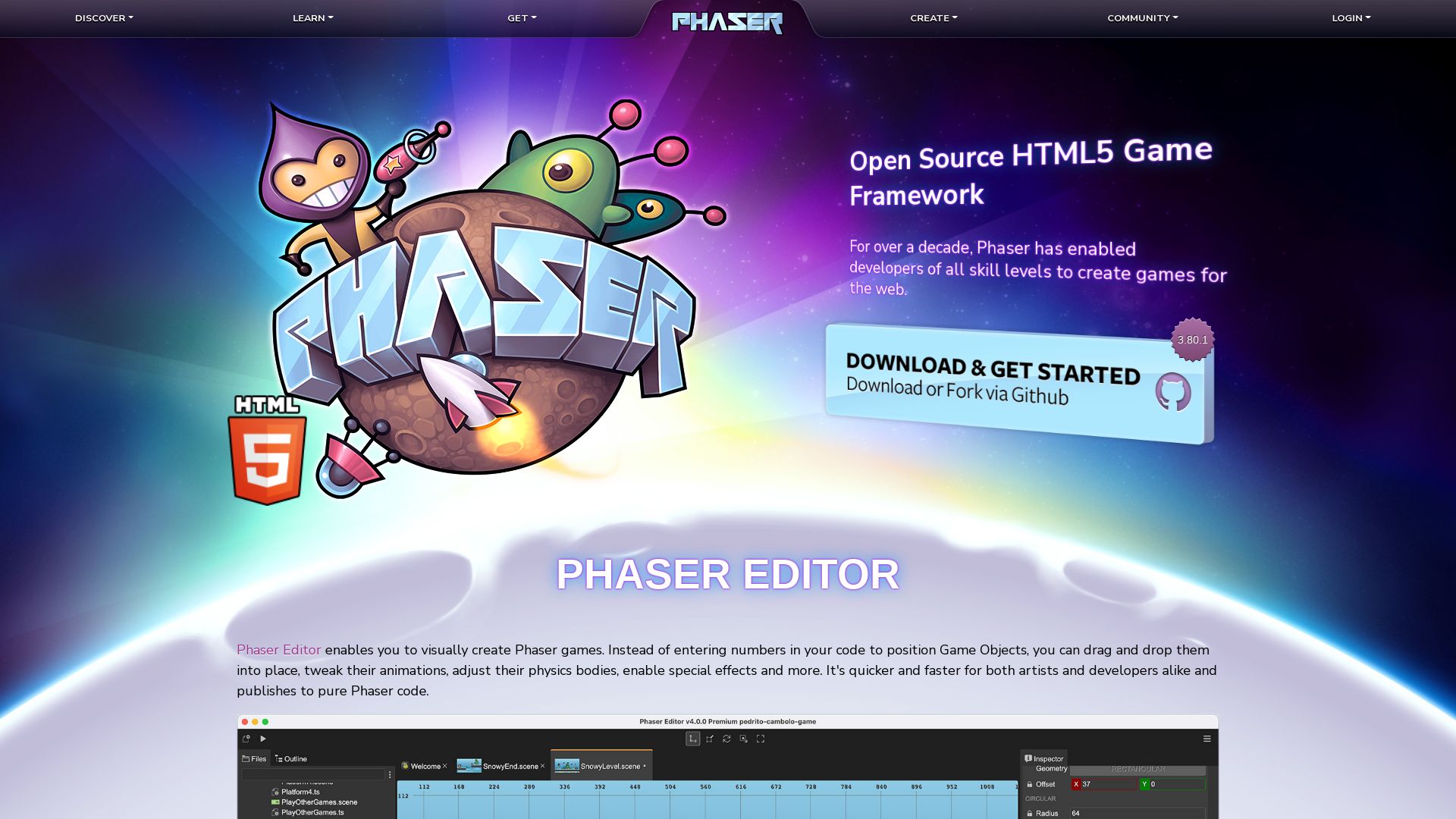
Phaser, the brainchild of Richard Davey in April 2013, is your weapon of choice to the world of 2D game development. With a backbone solidly built on JavaScript and TypeScript, it sails smoothly in crafting HTML5 games for both desktop and mobile platforms.
Phaser Top Features
- Quick Rendering: Harness the power of Phaser’s two-edge sword with Canvas & WebGL renderers to whip up a fast, seamless game rendering.
- Cross-Platform Deployment: Move freely across boundaries with Phaser! Your games can easily be deployed to iOS, Android, and native desktop apps via Apache Cordova, PhoneGap.
- Rapid Development & Ongoing Support: Phaser presents you with multiple versions each giving you benefits like modular structure, custom WebGL renderer, and ongoing development on GitHub.
- Compatible Browser Support: Phaser extends its hand of compatibility to any browser that supports the canvas element.
- Multiple Physics Systems: Get a grip on Arcade Physics, Ninja Physics, P2.JS to add the extra spark of reality in your games.
| Key Features | Advantages |
|---|---|
| Sound Playback | Web & HTML5 audio for a mesmerizing auditory experience |
| 1800+ Examples | Game development made easy — so you never get stuck |
| Zenva Academy’s Phaser Mini-Degree | Praised for leading beginners from zero to hero within a short learning curve |
Phaser Downsides
While Phaser is an excellent toolkit, it faces certain limitations.
- Phaser may seem overwhelming for beginners due to its extensive features and capabilities.
- Despite extensive browser compatibility, certain features may fall short on older or less common browsers.
Phaser Pricing
Phaser champions the spirit of open-source and is available for free! So you can dive into your game development journey without having to worry about any additional costs.
Phaser Use Cases
Use case 1
If you’re venturing into Android game development, Phaser’s support for es6+webpack, CDN, TypeScript, makes it the go-to solution.
Use case 2
Looking to create an addictive Facebook Instant game? Phaser’s easy deployment and browser compatibility are your perfect canvas.
Use case 3
With Phaser, even as a beginner aspiring to build your first HTML5 game, be confident! Phaser’s beginner-friendly resources are your safety net.
Construct 3

Seamlessly bridging the artistic and the algorithmic, Construct 3 enters the game development coliseum – an incandescent beacon for both neophytes and technocrats alike. Expertly crafted by Scirra Ltd, Construct 3 births a new era of HTML5-based 2D video game engines, breathing life into creative visions with a resplendent display of logical agility and software finesse.
Construct 3 Top Features
- Embrace the empowerment of event sheets – a triumph of visual programming enabling agile game creation.
- Experience browser flexibility – an inclusive gateway, extending access to a pantheon of devices with offline use option.
- Navigate an in-built pixel editor – a hallowed canvas for your game graphics.
- Unleash the strength of solid and platformer behaviors, coupled with tile movement and anchor abilities.
- Savor JavaScript as an optional scripting language – a feature valued by advanced users and heralded for its flexibility.
- Export games effortlessly into a web app or through an HTML wrapper.
| Unique Feature | Description |
|---|---|
| Compliance | Fully compliant with data privacy regulations such as COPPA, CCPA, and GDPR. |
| Web Support | Accommodates a wide variety of browsers, including Google Chrome, Firefox, Internet Explorer 9+, Safari 6+, and Opera 15+. |
| Educational Resources | Resources such as a starter curriculum, tutorials, and manuals are available, bolstering support for educators. |
Construct 3 Limitations
- While robust, Construct 3 may encounter hurdles in the creation of large-sized games.
- Though proficient in 2D game development, Construct 3 is not feasible for 3D projects.
- The platform lacks native exporters and offline application support, inhibiting creations on platforms like Apple TV.
- Exporting for HTML5 and Construct 3 is bound by the device’s support for web content.
Construct 3 Pricing
Scirra proffers a free license version of Construct 3 with an option for a paid subscription, granting access to a multitude of features. The starting cost for the personal plan stands at $99/year.
Construct 3 Use Cases
Use case 1: Educational Curriculum
Construct 3 has quickly become the chosen tool for educators in 400 schools across 48 states in the US. Its simple programming process and downloadable feature make it an optimal choice for schools in regions with sporadic internet connectivity. It’s an ingenious way to instill coding and game designing skills in the malleable minds of students.
Use case 2: Indie Developers
The enticing allure of rapid 2D game development has birthed a substantial fanbase in the world of indie developers. The engine’s proclivity for non-coding language based operations significantly trims time in game development.
Use case 3: Advertising
Construct 3 dances to the rhythm of modern trends, supporting HTML5-based web applications and playable advertisements, making it a viable option for advertising agencies and social media marketers.
Panda3D

Panda3D, a competent game engine, was developed for 3D rendering and game development. Created with Python and C++, this engine’s journey began with Disney Interactive and has thrived since its release in 2002. Currently standing at version 1.10.13, Panda3D’s open-source capabilities continue to evolve on its GitHub repository.
Panda3D Top Features
- Powerful engine supporting both C++ and Python
- Comprehensive suite of functionalities relevant to 3D game creation, including graphics, audio, I/O, collision detection
- Structures managed automatically by Python’s garbage collector for efficient runtime
- Provision for custom shaders, modern per-pixel lighting techniques, gloss map, normal map, and automatic shader synthesis
- Other key capabilities – 3D audio using FMOD, OpenAL, or Miles Sound System, physics system, collision detection, keyboard and mouse support, finite state machines, networking, AI
- Extensive documentation and vibrant, supportive community.
| Engine Language | C++, Python |
| First Release | 2002, current release 1.10.13 (2022) |
| Supported Platforms | Microsoft Windows, Linux, macOS, FreeBSD |
| GitHub Repository | Panda3D GitHub |
| Website | www.panda3d.org |
Panda3D Limitations
- Not aimed at beginners, requires basic understanding of Python and APIs
- Building and configuration may pose challenges and have specific instructions for different platforms
Panda3D Pricing
Panda3D, in line with the spirit of open-source development, is available for free. It also welcomes financial support via its OpenCollective campaign.
Panda3D Use Cases
Use case 1: Large Commercial Games
Panda3D’s robust suite of features and high-level scripting has been leveraged in large commercial games like Toontown Online, Pirates of the Caribbean Online, among others.
Use case 2: University Courses
Its comprehensive functionalities and the support of Python make Panda3D a suitable engine for academic settings, where students can learn and experiment with game development.
Use case 3: Open-Source Projects
Being open-source, Panda3D encourages collective innovation and is a preferred option for developers aiming to contribute to and collaborate on open-source projects.
Solar2D

Enter the universe of Solar2D, a cross-platform mobile app development software. Known for its real-time testing and wide array of plugins, Solar2D wields the power of Lua scripting language employed in big-name game franchises like Warcraft and Angry Birds. Previously known as Corona SDK, this platform carries a legacy of over 10 years of active development and a community of thousands, while prioritizing privacy—no sneaky tracking or data gathering here.
Solar2D Top Features
- Flexible development—Script in Lua, C++, Obj-C, C, Java.
- Universal compatibility—Create apps for Android, iOS, Windows, Linux, MacOS, and various TV devices.
- Real-time testing—With the instant-update Simulator and Live Builds, see your code and asset alterations immediately.
- Extensive in-app solutions—Access a vast array of plugins for advertising, analytics, media through Solar2D Marketplace.
- Open-source framework—Modify and distribute under MIT open source license.
| Focus | Details |
|---|---|
| Design possibilities | Numerous options for developers to realize their creative visions. |
| Developer support | A vibrant, supportive developer community with additional resources from Developer Guides, API Reference site. |
| Quick monetization | Integrated advertisement support promotes faster monetization. |
Solar2D Limitations
- Apart from being a prevalent scripting language in gaming, Lua may not be as widely recognized or used in other fields.
- While Solar2D Native allows calls to native libraries/APIs, it might demand a learning curve for beginners.
Solar2D Pricing
Solar2D shines even brighter in its affordability. It’s 100% free, with no hidden fees or royalties to worry about.
Solar2D Use Cases
Use case 1: Independent Game Developers
With Lua being a leading scripting language in games, Solar2D offers a platform well-aligned with gaming, ideal for individual developers or small studios venturing into the mobile gaming realm.
Use case 2: Edtech Enterprises
Solar2D, with its flexibility and wide range of platform support, is equally valuable for Edtech enterprises aiming to develop engaging learning applications which require real-time alterations according to individual learners’ needs.
Use case 3: Media Companies
For media companies looking to develop their own app, the extensive array of plugins available in Solar2D, including those for in-app advertising and analytics, make it a robust, cost-effective choice.
Heaps

A mature cross-platform graphics engine, Heaps specializes in the creation of high-performance games. It is crafted with the Haxe programming language and has established a substantial reputation through powering games like Rushberry Mercs, Voidrun, Nuclear Blaze, Evoland, among others.
Heaps Top Features
- Multiplatform compatibility: Being a cross-platform engine, developers can build games for a multitude of platforms.
- 2D and 3D capabilities: Heaps supports both 2D and 3D game development, offering flexibility for developers.
- Powerful GPU leverage: It optimizes the use of modern GPUs for advanced performance.
| Feature | Benefit |
|---|---|
| Versatility | Supports multiple game genres – Arcade, Role-playing, Real-time strategy, Turn-based strategy, and more. |
| Haxe programming language | Rendering Haxe a useful tool to build up portability, with gradual integration of its output into a codebase. |
| Performance optimization | Known for its stability, exhibiting its power in game titles like Dead Cells and Northgard. |
Heaps Limitations
- More of a library: Unlike Godot and Unity, Heaps gravitates more towards a library than a full-fledged game engine.
- Requires familiarity with Haxe: Developers need to have a grounding in the Haxe programming language to make use of Heaps.
Heaps Use Cases
Use case 1
For developers wishing to leverage a platform-independent language. Heaps offers a potent alternative, particularly highlighted by the Flash community’s shift to Haxe after Flash’s demise.
Use case 2
Developers aiming to craft deep storylines and complex game systems find Heaps beneficial due to its powerful GPU leverage and performance optimization.
Use case 3
Game creators looking to share their content, especially indie developers, can benefit from its strong community connection and robust performance showcased in high-profile games.
GameSalad
Fulfill your game development dreams with GameSalad, a free, drag-and-drop game creation engine designed to bring your ideas to life on various platforms such as iPhone, iPad, Android, and HTML5.
GameSalad Top Features
- Complex behavior libraries: Craft games with intricate behavior libraries, enabling creativity on an unprecedented scale.
- In-App Previewer: Test your games right where they are designed for a seamless user experience.
- Multi-platform Publishing: Get your game out there on Android, iOS, Windows, and the Amazon Marketplace.
- GameSalad Creator: A unique platform that foregrounds Computational Science (CS) principles in the game development process.
| Education Support | Offers |
|---|---|
| Discounts: | Specially designed discounts for students, educators, and the US Military. |
| School Partnerships: | Working hand-in-hand with high schools in Texas and Illinois to foster game design education. |
| Curriculum Alignment: | Curriculum syncs with ISTE standards, state CS standards, and the K-12 CS Framework. |
GameSalad Limitations
- Discontinued free memberships in 2015, diminishing its accessibility.
- Downsized significantly by laying off half of the staff between October-November 2012, raising concerns about stability.
GameSalad Pricing
While GameSalad began with the “Free-to-Make” model in 2010, the company discontinued free memberships in 2015. The platform now operates on a pricing model, but it is notably supportive of education sectors with discounts for students, educators, and the US Military.
GameSalad Use Cases
Use Case 1: STEAM Learning
GameSalad promotes STEAM learning by offering an accessible platform for students to explore and create their own games, thereby developing computer science concepts, logical thinking, and problem-solving skills.
Use Case 2: Cross-Platform Game Development
For developers aiming to create games for multiple platforms, GameSalad’s comprehensive web publishing system enables easy cross-platform publishing, reducing the difficulty of compatibility issues.
Use Case 3: Turnkey Game Design Education Program
Schools looking for a turnkey game design program can leverage GameSalad’s curriculum, which aligns with diverse educational standards, in their classrooms. It’s an ideal solution to teach students coding and problem-solving in an engaging and practical way.
Stride
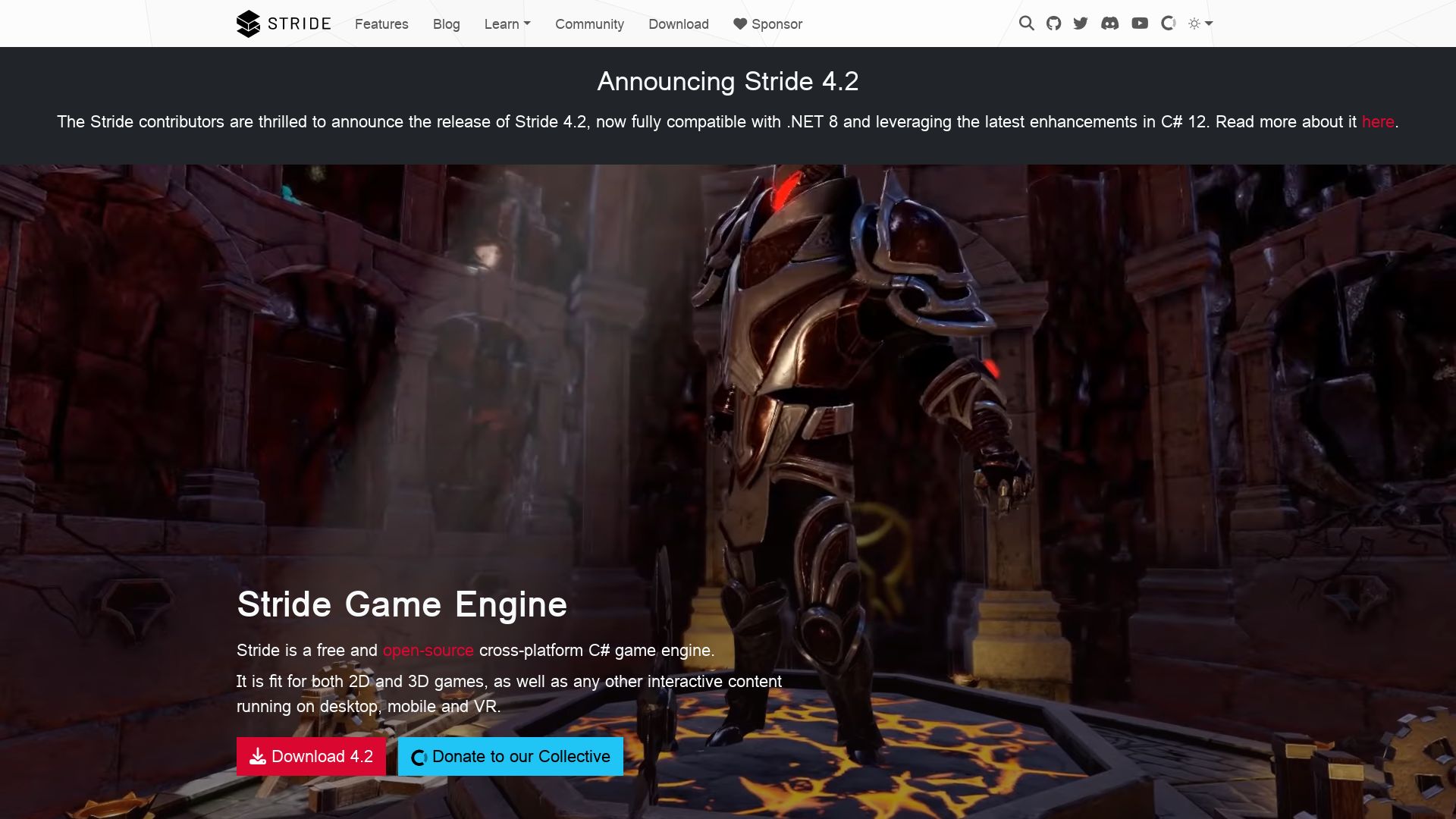
Presenting Stride, a robust, open-source, 2D and 3D game engine, developed by Silicon Studio, known originally as Xenko. This powerful engine caters to a vast array of platforms, including PC, mobile devices, and even virtual reality.
Stride Top Features
- C# suite tools: Offers a comprehensive toolset for game developers with a preference for C#.
- Customizable shader system: Facilitates the creation of visually appealing game assets.
- Stride Game Studio: An integrated environment covering essential aspects from asset import and scene creation to scripting and game building.
| In-built assets | Consolidates a range of tools, from PBR layered material editor to sprite and scripting editor. |
| Cross-platform runtime support | Suitable for myriad platforms including iOS, Android, Windows UWP, Linux, and PlayStation 4. |
| 3D rendering capabilities | Also serves as a rendering engine for vvvv gamma, a visual programming environment. |
Stride Downsides
- Silicon Studio cease in support since August 2018, giving way to a community-supported model.
- Transition from Xenko to Stride in April 2020, potentially leading to a period of adjustment for longstanding users.
Stride Pricing
Stride is free and open-source, making it a cost-effective engine for game development.
Stride Use Cases
Use case 1
Stride’s entity component system and integrated development environment are ideal for indie developers aiming to create their own games.
Use case 2
Its cross-platform support makes it suitable for developers focusing on mobile gaming market.
Use case 3
With VR support, Stride proves beneficial for those venturing into the realm of virtual reality gaming.
RPG Maker
Initiated by ASCII and Enterbrain in 1992, RPG Maker has developed multi-linguistic (Japanese, Chinese, Korean, English) game development tools. The focus is on crafting RPGs with a strong story-driven element. Owing to its success on several platforms, it has fostered a new breed of gaming.
RPG Maker Top Features
- Story-driven RPG creation: Specifically tailored for RPGs emphasizing narrative.
- Cross-platform: Compatibility with an array of platforms including Windows, PlayStation, Xbox One, Nintendo Switch, and Linux.
- Robust character creation: Diversified character conception with the latest RPG Maker MV version.
- Community-driven: Thrives on an extensive support network and shared modifications among users.
| Easy Use | No prerequisite coding knowledge, ideal for budding developers. |
| Free plugins | Broad range of (mostly) free plugins to enhance gameplay. |
| DLCS availability | Over 200 DLCs priced from $5-$25 enrich the gameplay ecosystem. |
RPG Maker Downsides
- Engine limitations: Not all designs possible, requires proficient developer to avoid failure.
- Controversies: Titles like “Super Columbine Massacre RPG!” and “Heartbeat” sparked disputes.
RPG Maker Pricing
With over 200 DLCs available, prices differ between $5-$25. Note that, while the main engine may be accessible, some features carry costs.
RPG Maker Use Cases
Use case 1
Firstly, RPG Maker is an excellent choice for young developers looking to understand and acquire experience in game development due to a user-friendly interface and minimal coding premise.
Use case 2
Secondly, it offers a unique platform for games focusing on a story-driven approach, like Harvest Island, hence capitalizing on creative facets despite technical limitations.
Use case 3
Lastly, RPG Maker aids in fostering an intensive, underpinning community of users who learn and grow through shared modifications and improvements.
Logan Bellbrook
Content writer @ Aircada with a knack for nature & AR/VR/XR. Blogging the intersection of tech & terrain.



